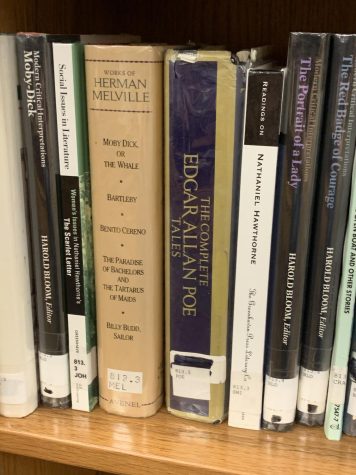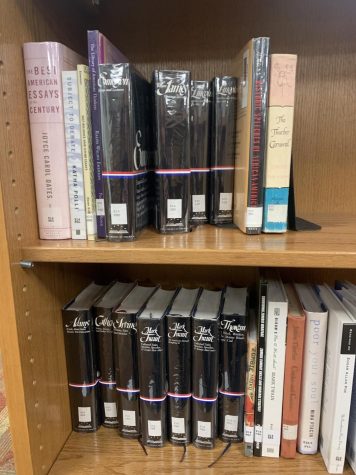Evolution of Literature
February 13, 2023
According to the Oxford dictionary, literature is “any written work, especially those considered of superior or lasting artistic merit.” Some classic pieces of literature that are popular titles include: “To Kill a Mockingbird,” “The Great Gatsby” and “Animal Farm.” Over the years, what people view as “good literature” has shifted.
The earliest literature began in the Bronze Age. Most literature from this time was taken directly from stories told by hunters and gatherers through oral retellings, many of which are myths and folklore still passed through certain cultures today.
The history of writing as a medium began independently in many different parts of the world. It began in Mesopotamia in approximately 3200 BC, in Ancient China in about 1250 BC and about 650 BC in Mesoamerica; however, literature was separate from writing which was originally used for things such as accounting. Some of the earliest surviving pieces of ancient literature are “The Maxims of Ptahhotep,” “Story of Wenamun,” “Poor Man of Nippur” and “Classics of Poetry.”
Sumerian literature is the oldest known type of literature. All types of Sumerian literature contained poetic aspects and demonstrated the basic elements of poetry: lines, imagery and metaphor. The stories were primarily shared orally, but were written down by scribes. Sumerian literature did not have titles, and said literature was instead referred to by the first line of the piece.
Literature from the Old Kingdom of Egypt was developed from practical use in the Fifth Dynasty. Lists of offerings for the gods and information about state officials were transformed into something closely resembling an autobiography. These pieces often contained a mixture of poetry and prose in a free-flowing style. The “Instructions” was a form of wisdom literature used during Ancient Egyptian history. It taught Ancient Egyptian philosophy that mixed pragmatic thought and religious speculation.
This way of writing continued into the Middle Kingdom of Egypt as autobiographies evolved into a more intricate type of writing. The role of the king also evolved in this period of time. Royal testaments were written from the perspective of the king to his successor, and the king was celebrated in these autobiographies. Also at this time, fiction and the comparisons of good and evil began. During the New Kingdom of Egypt, literature as entertainment became prominent among the nobility and wealthy. This form of literature incorporated aspects of narrative, myth, religious hymns, love songs and praise for the king.
Anthologies were used as a way to criticize and determine literary classics in Ancient China. The “Classic of Poetry” is the oldest existing anthology of Chinese poetry. It comprised 305 works by different anonymous authors. The “Chu Ci” anthology is a volume of poems from the Warring States period and was attributed to Qu Yuan. These poems were written to be recited in a certain rhythm, but not sung. Along with this came historical documents, which became an early form of literature. The documentation of real historical events got combined with narrative and sometimes epic recounts of history. The “Zuo Zhuan” is now considered the first large-scale narrative work in Chinese literature.
In the Han dynasty, poetry was split into multiple different branches. It included short length, parallel exposition, rhymed expositions and idealism became popular at this time. Poetry during this time left behind tetrasyllabic, having four syllables, for pentasyllabic, having five syllables, verses. The ballads of Chu took China by storm. These ballads focused on concepts such as fate and destiny.
In early Greece, literature was composed in dactylic hexameter. Homer was a prolific writer. He was very well known for his epic poems such as the “Iliad” and the “Odyssey.” Hesiod was credited with the development of traditional poetry, such as “Megala Erga” and “Theogony.”
In the Roman Republic, literature was full of tragedies, comedies and epic poems. Livius Andronicus was credited as the originator of literature in the language of Latin. After the Roman empire was formed, poetry took over the market previously full of political commentary and prose. Virgil, Horace, Propertius and Ovid are considered to have made up the Golden Age of Latin literature.
After the fall of Rome, medieval literature focused increasingly on faith and religious topics. Hagiographies were very common in medieval Europe. The works of Aristotle began returning to Europe in the 13th century, leading to authors such as Thomas Aquinas turning theology into a more science-based topic. “The Decameron” by Giovanni Boccaccio was the first to introduce the term novella.
The Renaissance saw an increase in ancient works of Rome and Greece. Literature was mainly funded through the patronage of nobles. The production of the printing press in the 15th century also greatly increased the spread of literature. Something that also incited this rise was an increase in the literacy of the people. Many changes were made in this time through the literature. A big scientific discovery was made with “De Revolutionibus Orbium Coelestium.” In this, Nicolaus Copernicus explains that he does not believe that the Earth is the center of the universe. This made big waves not only in science, but also in literature, due to it causing more questions about religion and increasing the number of people seeking the truth. Plays also became more popular again, especially the works of William Shakespeare.
In the 18th century, the Age of Enlightenment began. This could be observed from the popularity of authors such as Voltaire, Jean-Jacques Rousseau and Adam Smith. This was followed by the beginning of Romanticism in the second half of the century. In the 19th century, Romanticism was countered with Realism and Naturalism.
In Britain, the 19th century was full of romantic poets such as William Wordsworth, Lord Byron and Samuel Taylor Coleridge. Charles Dickens was also actively writing during this time.
During the American Revolution, literature was mostly political with works like “A Summary View of the Rights of British Americans” by Thomas Jefferson and “Common Sense” by Thomas Paine. “The Power of Sympathy” by William Hill Brown was called the first American novel.
Judith Sargent Murray was credited with the creation of the American feminist movement through her essays and poetry. Edgar Allen Poe was also popular; he had a large part in Gothic literature becoming a normal form of literature. During this time, Nathaniel Hawthorne wrote stories about morals such as “The Scarlet Letter.” Emily Dickinson was very popular in the later centuries, due to her work being refused to be published during her lifetime.
Transcendentalism also became popular through the works of Ralph Waldo Emerson. Freed slaves such as Frederick Douglass and Harriet Jacobs wrote autobiographical stories that helped with the fight for the abolishment of slavery. Realism and Naturalism also grew in popularity.
Contemporary literature is composed of any literature written after World War II. Postmodern literature was written from about 1945 to 1980. Genres such as fantasy and science fiction emerged in this time.
Literature has gone through many changes through the years to get to where it is today. Whether it be classical literature or contemporary every person can find something that fits their personal taste.

(Addison Stiller)


